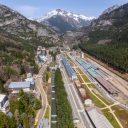SNCF Réseau begins public consultations to reopen strategic France-Spain rail line

France's infrastructure manager SNCF Reseau has a begun a three-month period of public consultations concerning a major project to re-open the Pau-Canfranc railway line through the Pyrenees by 2032. The project concerns the upgrading and adaption of rail infrastructure along an 85-kilometre stretch from Pau to the entrance to the Somport rail tunnel on the French Spanish border, closed since 1970. An estimate published earlier this month put the cost of re-opening the French section of the Pau-Canfranc line at 450 million euros.
Last year, the European Commission renewed its support for the project by granting 9.1 million euros towards a programme of technical studies within the framework of the European Interconnection Mechanism (EIM). Rail's modal share of freight traffic between France and the Iberian Peninsula currently represents less than two percent of overall freight traffic, according to SNCF Reseau. If given the go-ahead it would have a potentially significant impact on train-borne freight traffic between France and Spain taking 60,000-80,000 trucks off the road each year.
Studies carried out on the project back in 2019 estimated potential freight traffic at two million tonnes annually. More recent research points to the possible operation of ten round trips by freight trains daily, eight of which dedicated to combined road-rail transport.

The re-opening of the line would improve the safety of passengers and hauliers using the roads on the Trans-Pyrenees route, where accidents involving HGVs are frequent, due to the particular geography of the region and the high volumes of truck traffic between France and Spain, the project's backers note. It would also contribute to combating the air pollution generated by truck traffic, as well as the damage done to the fragile, natural mountainous environment.
One more route to Zaragoza
According to a White Paper published by the Nouvelle-Aquitaine region, demand for rail freight through the Pyrenees would be generated mainly by French and Spanish players in the cereals/agricultural products and automotive sectors.
SNCF Reseau underlined that at the end of the trans-Pyrenees rail line lies the 'Plaza' logistics hub in Zaragoza, which handles around 70% of freight flows from Spain to Europe. It is also linked to dry ports such as Barcelona, Valencia and Madrid, who in turn provide a link between Europe and Asia. A rolling highway operates from the Plaza hub in Zaragoza to the port of Algeciras, on Spain's southern tip - a strategic point for trade with Africa and Latin America.
The Spanish authorities are working on a national logistics plan which would see the development of seven rolling highways running from and to Zaragoza.

You just read one of our premium articles free of charge
Want full access?
Take advantage of our exclusive offer
References
- ^ See the offer (www.railfreight.com)